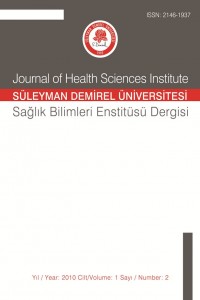Öz
EXAMINATION OF EFFECT OF AGING PROCEDURE ON SURFACE ROUGHNESS OF DIFFERENT RESTORATIVE MATERIALS
ABSTRACT
Objective: In this study; the aim was to examine the effect of aging procedure on surface roughness of compomer, composite and ormocer resin restorative material samples after polimerizing with halogen light unit, in vitro.
Method: In the study, three different compomer resin (Compoglass-F, Glasiosite, Dyract-Extra), two different nanohybrid composite resin (Grandio, Filtek-Supreme) and one ormocer resin (Admira) materials were used. Material samples were placed in “7mm x 1mm” sized cylindirical teflon molds. All samples were polymerized with halogen light unit (n=7, totally 42 samples) (Color:A2). After polimerizing procedure, all samples were subjected to one-year aging procedure with “temperature, moisture and light” loops with an aging device (Atlas Weathering Machine). The surface roughness values were calculated before and after aging procedure. All data were determined with Three-Way-ANOVA and Duncan Multiple-Comparison-Test statistically (p<0,05).
Results: There were statistical differences between materials in terms of surface roughness (p<0,05). The highest surface roughness values were present in samples of Admira ormocer material statistically (p<0,05). The lowest surface roughness values were in samples of Compoglass-F compomer material (p>0,05). It was not found any difference between groups due to aging procedure statistically (p >0,05).
Discussion: Any significant difference on surface roughness was not observed regarding to aging procedure. However, when the types of materials were evaluated, it was observed that the ormocer resin material has shown more surface roughness than all other resin based restorative materials.
Key words: Dental Restorative Materials, Dental Composites, Light-Cured Composites, Surface Roughness.
Anahtar Kelimeler
FARKLI RESTORATİF MATERYALLERİN YÜZEY PÜRÜZLÜLÜĞÜ ÜZERİNDE, YAŞLANDIRMA PROSEDÜRÜNÜN ETKİSİNİN İNCELENMESİ
Öz
Özet
Amaç: Bu çalışmada; halojen ışık kaynağıyla polimerize edilen kompomer, kompozit ve ormoser rezin restoratif materyal örnekleri üzerine uygulanan yaşlandırma prosedürünün, materyallerde meydana gelen yüzey pürüzlülüğü üzerine etkisinin in-vitro olarak incelenmesi amaçlanmıştır.
Yöntem: Çalışmada, 3 farklı kompomer rezin (Compoglass-F, Glasiosite, Dyract-Extra), 2 farklı nanohibrit kompozit rezin (Grandio, Filtek-Supreme) ve 1 ormoser rezin (Admira) materyal kullanıldı. Materyal örnekleri “7mm x 1mm” ebatlarındaki silindirik şekilli teflon kalıplara yerleştirildi ve ardından tüm örnekler halojen ışık kaynağıyla polimerize edildi (n=7, toplam 42 örnek) (Renk: A2). Polimerizasyon işleminin ardından tüm örnekler, “ısı, nem ve ışık döngüleri” ile in-vitro olarak yaşlanma prosedürü uygulayan bir yaşlandırma cihazı (Atlas Weathering Machine) yardımı ile 1-yıllık yaşlanma prosedürüne tabi tutuldu. Yaşlandırma prosedüründen önce ve yaşlandırma prosedürünün ardından örneklerin yüzey pürüzlülük değerleri ölçülerek veriler istatistiksel olarak Üç-Yönlü-ANOVA ve Duncan Çoklu-Karşılaştırma-Testi kullanılarak değerlendirildi (p < 0,05).
Sonuçlar: Yüzey pürüzlülüğü açısından, materyaller arasında istatistiksel farklılıklar mevcut iken (p < 0,05), yaşlandırma prosedürünün ardından gruplar arasında istatistiksel farklılık bulunmadı (p > 0,05). Materyaller arasında istatistiksel olarak en fazla yüzey pürüzlülüğü değerlerini, Admira ormoser rezin restoratif materyalinden oluşan örnekler gösterdi (p < 0,05). Çalışmadaki en düşük yüzey pürüzlülüğü değerlerine ise Compoglass-F kompomer rezin restoratif materyalinde rastlandı (p > 0,05). Tartışma: Çalışmada, yaşlandırma prosedürüne göre, örneklerin yüzey pürüzlülüğü değerleri arasında belirgin bir farklılık bulunmamıştır. Bununla birlikte, çalışmada kullanılan farklı rezin materyaller bakımından, ormoser materyalin diğer materyallere oranla daha fazla yüzey pürüzlülüğü gösterdiği izlenmiştir.
Anahtar Sözcükler: Dental Restorative Materials, Dental Composites, Light-Cured Composites, Surface Roughness.
Abstract
Objective: In this study; the aim was to examine the effect of aging procedure on surface roughness of compomer, composite and ormocer resin restorative material samples after polimerizing with halogen light unit, in vitro.
Method: In the study, three different compomer resin (Compoglass-F, Glasiosite, Dyract-Extra), two different nanohybrid composite resin (Grandio, Filtek-Supreme) and one ormocer resin (Admira) materials were used. Material samples were placed in “7mm x 1mm” sized cylindirical teflon molds. All samples were polymerized with halogen light unit (n=7, totally 42 samples) (Color:A2). After polimerizing procedure, all samples were subjected to one-year aging procedure with “temperature, moisture and light” loops with an aging device (Atlas Weathering Machine). The surface roughness values were calculated before and after aging procedure. All data were determined with Three-Way-ANOVA and Duncan Multiple-Comparison-Test statistically (p < 0,05).
Results: There were statistical differences between materials in terms of surface roughness (p < 0,05). The highest surface roughness values were present in samples of Admira ormocer material statistically (p < 0,05). The lowest surface roughness values were in samples of Compoglass-F compomer material (p > 0,05). It was not found any difference between groups due to aging procedure statistically (p > 0,05). Discussion: Any significant difference on surface roughness was not observed regarding to aging procedure. However, when the types of materials were evaluated, it was observed that the ormocer resin material has shown more surface roughness than all other resin based restorative materials.
Key words: Dental Restorative Materials, Dental Composites, Light-Cured Composites, Surface Roughness.
Anahtar Kelimeler
Ayrıntılar
| Birincil Dil | İngilizce |
|---|---|
| Bölüm | Araştırma Makaleleri |
| Yazarlar | |
| Yayımlanma Tarihi | 5 Ocak 2011 |
| Gönderilme Tarihi | 13 Kasım 2010 |
| Yayımlandığı Sayı | Yıl 2010 Cilt: 1 Sayı: 2 |


